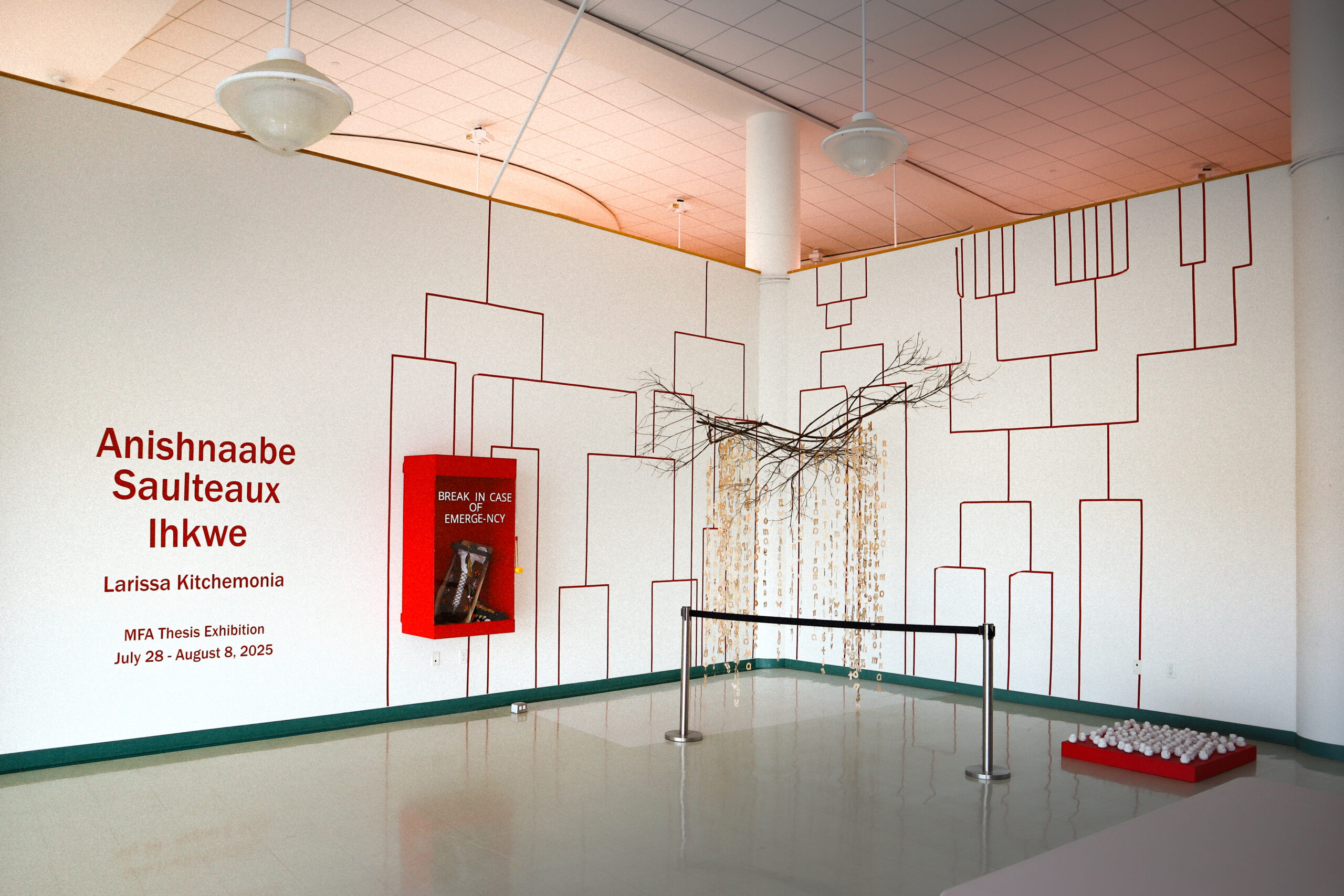
Regina, SK — From July 28 to August 8, the multipurpose room at First Nations University of Canada (FNUniv) became a space for cultural preservation, language revitalization, and intergenerational storytelling through the work of Master of Fine Arts student Larissa Kitchemonia. Her thesis installation brought together three distinct yet interconnected projects, each rooted in Saulteaux culture and teachings.
“The artworks are all about Saulteaux cultural preservation,” Kitchemonia explained. Break in Case of Emerge-ncy explored material culture items and the preservation of child-rearing teachings passed down from her maternal grandmother. Living Language featured 39 Saulteaux language phrases cut from deer and elk rawhide, capturing “the idea of Saulteaux language possessing spirit and a living presence” as part of ongoing language revitalization and reclamation efforts. Little Nokos presented 100 “little grandmothers” gathered together, representing how women have shared knowledge since time immemorial.
“This body of work was inspired by the need and responsibility as an Anishnaabe Saulteaux woman to do my part to learn and pass on my culture to the next generations,” she said. Themes of representation, identity, language revitalization, and kinship ran throughout the installation.
Displaying the work at FNUniv was intentional. “I knew when I was creating this body of work that I wanted an Indigenous audience, so it was important that I was able to install the work at the [FNUniv] first,” Kitchemonia said.
For her, the most rewarding aspect was also the most personal: “Exploring a theme and project that was so personal and focused on Saulteaux culture was the most rewarding. There isn’t a lot of information about Saulteaux people in academia, and to be able to contribute for future students was intimidating and motivating for me.”
Through her work, Kitchemonia hoped to leave visitors with “a true, unromanticized version of Saulteaux culture from back home. A better understanding of Anishnaabe Saulteaux traditional culture and beliefs that focus on the importance of kinship. Maybe it will inspire others to explore their family knowledge and learn.
About the Artist

Larissa Kitchemonia is an Anishnaabe-Saulteaux woman from The Key First Nation, currently living in Regina, Saskatchewan. Her art explores themes of culture, nature, and customary Saulteaux ideas and practices through beading, painting and installation art. Larissa views her artworks as a way to create and contribute to Anishnaabe-Saulteaux presence in spaces. She is an alumnus of the First Nations University of Canada having completed a Bachelors degree in Indigenous Fine Arts. along with an ongoing after degree in Indigenous Education. Currently, she is a Masters of Interdisciplinary Studies candidate at the University of Regina and Sessional Instructor at the First Nations University of Canada.
Exhibition Statement
Anishnaabe Saulteaux Ihkwe is research through art-based exploration of the philosophy of understanding self and my place in an Anishnaabe-Saulteaux world. This body of work focuses on ontologies found within Anishnaabe-Saulteaux culture expressed through art. It is a journey into learning and often recalling cultural teachings and knowledges handed down through my family’s generations. The exhibition comprises three sculptural artworks and one vinyl wall surface design. The theme of Anishnaabe-Saulteaux culture and identity is explored through the use of sculpture. Typically, in the past, I have explored art making through painting or drawing mediums. This body of work uses sculpture as a conscious choice to exercise the act of taking up physical space and creating an Anishnaabe–Saulteaux presence. With the current climate of language and culture loss, Indigenous representation needs to be found in society. For the next generation to be able to see themselves accurately represented in non-stereotypical ways creates a positive and accurate narrative. In my community, there is little to no evidence of our own material culture, and this work could be a step in reintroducing cultural objects and teachings.